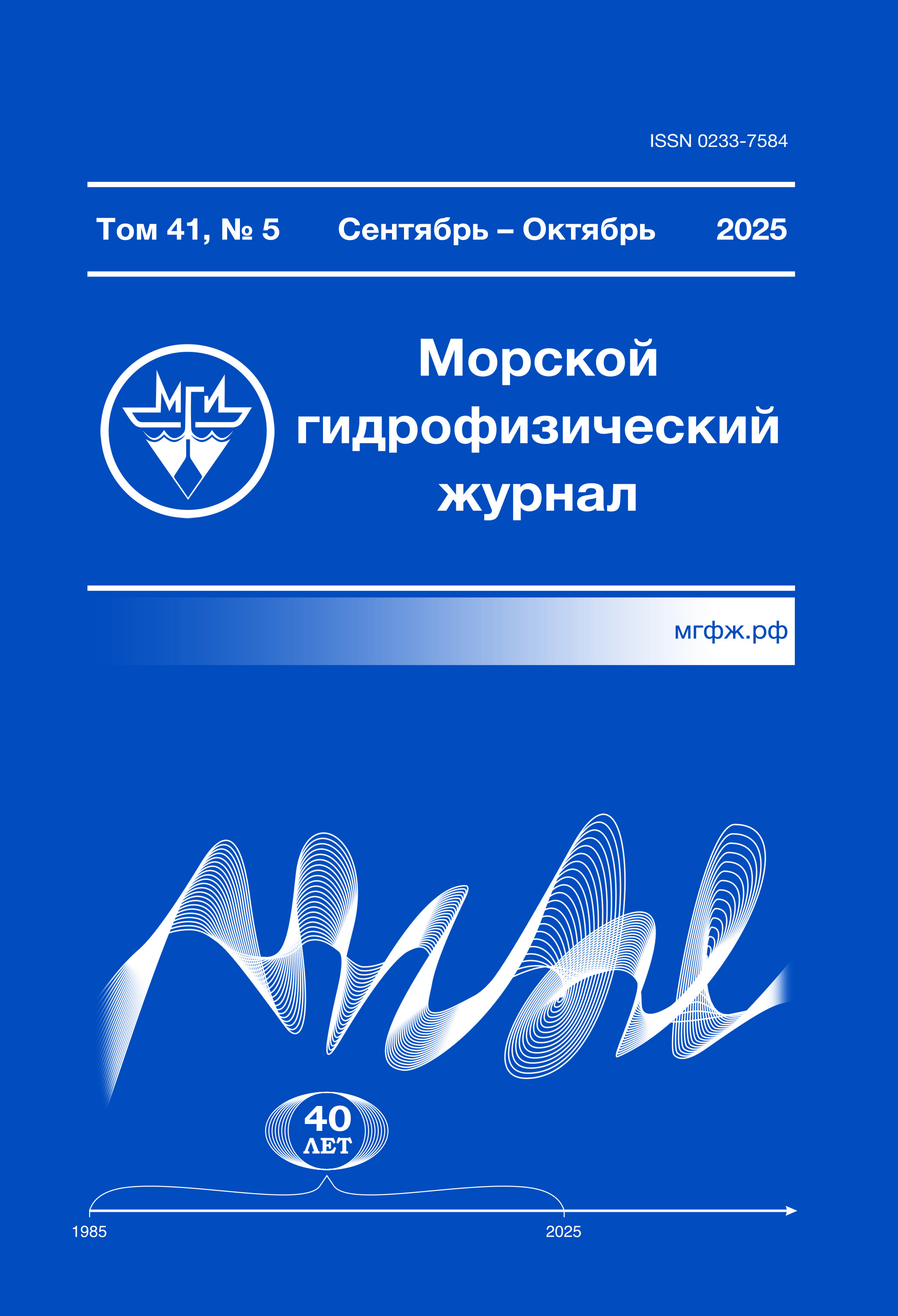Russian Federation
Russian Federation
Institute of Automation and Control Processes, Far Eastern Branch of Russian Academy of Sciences
Russian Federation
Higher School of Economics University
Nizhny Novgorod State Technical University n. a. R. E. Alekseev
Nizhny Novgorod, Russian Federation
Russian Federation
Purpose. The purpose of the work is to investigate the statistical characteristics of background microseismic field recorded using horizontal unequal-arm laser strainmeters, as well as to assess the data deviations from a normal distribution. Methods and Results. The research involved the data from two laser strainmeters developed on the basis of modern laser-interference techniques and installed at the marine experimental station of POI FEB of RAS “Shults Cape” (Primorsky Krai). The analysis was focused at the microdeformations of the Earth's crust upper layer measured by the laser strainmeters with measuring arm lengths 52.5 m (north – south orientation) and 17.5 m (west – east orientation). The microseismic noise field was statistically analyzed using the data from laser-interference devices for 2019–2020. The frequency range under consideration (0.05–0.5 Hz) includes microseisms of the events generated both by terrestrial and marine processes (the range of wind and swell waves). The statistical features of signals were comprehensively analyzed including the assessment of skewness and kurtosis coefficients, also the deviations from normal distribution were revealed. The Gram-Charlier series which shows the best correlation with the empirical data was applied to describe the density of probability function. Kurtosis was predominantly positive for both components that indicated a high likelihood of large-amplitude outliers. Conclusions. The performed analysis made it possible to assess quantitatively the background signal deviations from normal distribution, and to reveal its statistical features. The obtained results are very important for analyzing the background characteristics of microseisms, since the deviations from them allow studying the physical mechanisms of generation and interaction of oceanic, atmospheric and lithospheric processes.
microseismic oscillations, laser strainmeter, noise characteristics, statistical characteristics, skewness coefficient, kurtosis coefficient, Fourier transform, Gram-Charlier series
1. Geofizicheskiy poligon «Mys Shul'ca» / G. I. Dolgih [i dr.] // Vestnik DVO RAN. 2010. № 5. S. 165–169.
2. Vinogradov A. N., Vinogradov Yu. A., Malovichko A. A. Primenenie seysmoinfrazvukovo-go metoda monitoringa prirodnoy sredy dlya kontrolya geodinamicheskogo rezhima v zonah aktivnogo osvoeniya nedr Karskogo shel'fa i Yamala // Vestnik Kol'skogo nauch-nogo centra RAN. 2014. T. 4, № 19. S. 22–31.
3. Kovalev D. P., Kovalev P. D. Volny cunami u yugo-vostochnogo poberezh'ya o. Sahalin, vyzvannye izverzheniem vulkana Hunga–Tonga–Hunga–Haapay 15 yanvarya 2022 goda po nablyudeniyam donnymi volnografami // Vestnik Moskovskogo universiteta. Seriya 3. Fizika. Astronomiya. 2024. T. 79, № 3. 2430901.
4. Wind waves in the North Atlantic from ship navigational radar: SeaVision development and its validation with the Spotter wave buoy and WaveWatch III / N. Tilinina [et al.] // Earth System Science Data. 2022. Vol. 14, iss. 8. P. 3615–3633. https://doi.org/10.5194/essd-14-3615-2022
5. Seysmoakustiko-gidrofizicheskiy kompleks dlya monitoringa sistemy «atmosfera – gidrosfera – litosfera» / G. I. Dolgih [i dr.] // Pribory i tehnika eksperimenta. 2002. № 3. S. 120–122.
6. Remote Seismoacoustic Monitoring of Tropical Cyclones in the Sea of Japan / G. Dolgikh [et al.] // Remote Sensing. 2023. Vol. 15, iss. 6. 1707. https://doi.org/10.3390/rs15061707
7. Dolgikh G., Dolgikh S. Deformation Anomalies Accompanying Tsunami Origination // Journal of Marine Science and Engineering. 2021. Vol. 9, iss. 10. 1144. https://doi.org/10.3390/jmse9101144
8. Dolgih G. I., Dolgih S. G. Uchet vozdeystviya atmosfernogo davleniya na deformaciyu zemnoy kory // Doklady Rossiyskoy akademii nauk. Nauki o Zemle. 2021. T. 500, № 2. S. 168–172. EDN KNPVPJ. https://doi.org/10.31857/S2686739721100091
9. Dolgih G. I., Budrin S. S., Dolgih S. G. Preobrazovaniya variaciy pridonnogo davleniya, sozdavaemogo morskimi infragravitacionnymi volnami, v smescheniya verhnego sloya zemnoy kory. Kolichestvennaya ocenka // Doklady Rossiyskoy akademii nauk. Nauki o Zemle. 2024. T. 516, № 1. S. 433–439. https://doi.org/10.31857/S2686739724050147
10. Dolgih G. I. Issledovanie volnovyh poley okeana i litosfery lazerno-interferencionnymi metodami. Vladivostok : Dal'nauka, 2000. 160 s. EDN VPEMBB.
11. Observation of deep water microseisms in the North Atlantic Ocean using tide modulations / E. Beucler [et al.] // Geophysical Research Letters. 2015. Vol. 42, iss. 2. P. 316–322. https://doi.org/10.1002/2014GL062347
12. Le Pape F., Craig D., Bean C. J. How deep ocean-land coupling controls the generation of secondary microseism Love waves // Nature Communications. 2021. Vol. 12. 2332. https://doi.org/10.1038/s41467-021-22591-5
13. Tanimoto T., Anderson A. Seismic noise between 0.003 Hz and 1.0 Hz and its classification // Progress in Earth and Planetary Science. 2023. Vol. 10. 56. https://doi.org/10.1186/s40645-023-00587-7
14. Ocean wave sources of seismic noise / F. Ardhuin [et al.] // Journal of Geophysical Research: Oceans. 2011. Vol. 116, iss. C9. C09004. https://doi.org/10.1029/2011JC006952
15. Moni A., Craig D., Bean C. J. Separation and location of microseism sources // Geophysical Research Letters. 2013. Vol. 40, iss. 12. P. 3118–3122. https://doi.org/10.1002/grl.50566
16. Anthony R. E., Aster R. C., McGrath D. Links between atmosphere, ocean, and cryosphere from two decades of microseism observations on the Antarctic Peninsula // Journal of Geo-physical Research: Earth Surface. 2017. Vol. 122, iss. 1. P. 153–166. https://doi.org/10.1002/2016JF004098
17. Multi-instrument observations of microseisms generated by typhoon Kalmaegi (2014) over the Northwestern Pacific / J. Lin [et al.] // Earth and Planetary Science Letters. 2022. Vol. 594. 117746. https://doi.org/10.1016/j.epsl.2022.117746
18. Primenenie lazernyh deformografov vertikal'noy i gorizontal'noy orientacii v geofizicheskih issledovaniyah perehodnyh zon / G. I. Dolgih [i dr.] // Fizika Zemli. 2002. № 8. S. 69–73. EDN PKAOJB.
19. Lazernyy nanobarograf i ego primenenie pri izuchenii baro-deformacionnogo vzaimo-deystviya / G. I. Dolgih [i dr.] // Fizika Zemli. 2004. № 8. S. 82–90. EDN OXKCPP.
20. Dolgih S. G., Budrin S. S., Plotnikov A. A. Lazernyy izmeritel' variaciy davleniya gidrosfery s mehanicheskoy sistemoy kompensacii temperaturnogo vozdeystviya // Okea-nologiya. 2017. T. 57, № 4. S. 663–666. https://doi.org/10.7868/S0030157417040153
21. Dolgih G. I., Privalov V. E. Lazernaya fizika. Fundamental'nye i prikladnye issledo-vaniya. Vladivostok : OOO «Reya», 2016. 352 s. EDN YGMWEB.
22. Sayfullin R. T., Bochkarev A. V. Vychislenie koefficientov asimmetrii i ekscessa hro-matograficheskih pikov s primeneniem funkciy Chebysheva – Ermita i ryadov Grama – Sharl'e // Vestnik Samarskogo gosudarstvennogo tehnicheskogo universiteta. Seriya Teh-nicheskie nauki. 2020. T. 28, № 4. S. 89–105.
23. Montgomery D. C., Runger C. G. Applied Statistics and Probability for Engineers. United States of America : John Wiley Sons Inc., 2010. 784 p.
24. Slyunyaev A. V., Pelinovskiy D. E., Pelinovskiy E. N. Morskie volny-ubiycy: nablyude-niya, fizika i matematika // Uspehi fizicheskih nauk. 2023. T. 193, № 2. S. 155–181. https://doi.org/10.3367/UFNr.2021.08.039038


















